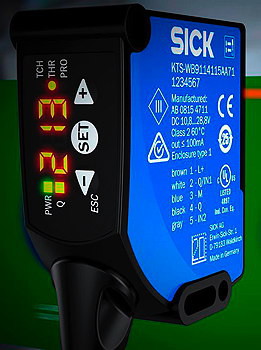- Home » News » Product News
Twin-channel contrast sensors solve many problems

The German sensor-maker Sick has launched a new generation of contrast sensors which, it claims, break new ground in terms of reliability, accuracy and versatility for print, labelling, converting and packaging applications, even in challenging conditions. With switching frequencies of up to 70kHz and jitter rates down to 3µs (a level never previously achieved), the KTS and KTX sensors can cope with up to 250 packs per minute and compensate for high-speed flutter on reel-to-reel material edges.
According to Sick, conventional contrast sensors can struggle to perform reliably when faced with jittering webs, high-gloss surfaces, or where there is not much difference in contrast between a mark and its background. It claims to have overcome these challenges by adding a second receiving channel – a first for a contrast sensor – thus achieving better stability and reducing the risk of machine downtime.
Sick’s Twin Eye Technology analyses an optically-split reflected signal from the material surface and compensates for any noise pulses to achieve stable, controlled switching. As a result, the new sensors have a much bigger depth-of-field, and a sensing distance tolerance of ±5mm – said to be unique in contrast sensors of this type.
The monochrome and colour sensors incorporate IO-Link communications and an on-board display for easy set-up and diagnostics. The display allows operators to input and query parameters, to “teach-in” the sensor, and to make process adjustments quickly and easily.

Users of Sick’s earlier KT5 contrast sensors can upgrade either to the smaller KTS or to the KTX, which has the same housing size. The sensors offer a colour-sensing capability without needing an extra device. Common applications, such as detecting print marks or controlling labelling, will benefit from the improved stability of the new technology.
According to David Hannaby, Sick’s UK product manager for presence detection, the new sensors “really are breaking new ground in contrast sensor technology. While still enabling print and packaging industries to continue to use a reliable and dependable workhorse, they ensure all the functionality users need to move to even better levels of performance, and to ensure that their machines are Industry 4.0-ready.”





